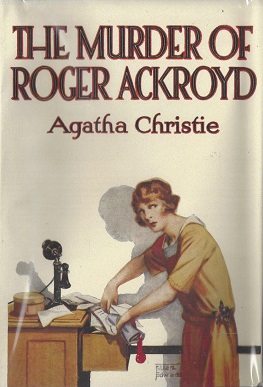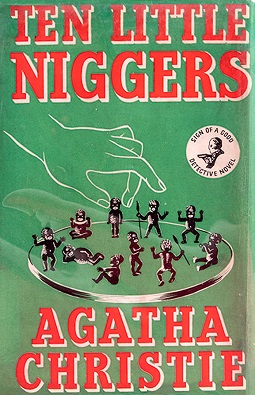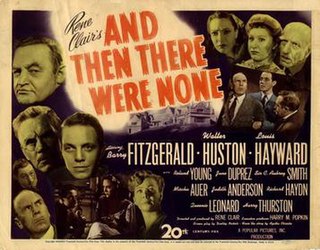
Dame Agatha Mary Clarissa Christie, Lady Mallowan, was an English writer known for her 66 detective novels and 14 short story collections, particularly those revolving around fictional detectives Hercule Poirot and Miss Marple. She also wrote the world's longest-running play, the murder mystery The Mousetrap, which has been performed in the West End of London since 1952. A writer during the "Golden Age of Detective Fiction", Christie has been called the "Queen of Crime". She also wrote six novels under the pseudonym Mary Westmacott. In 1971, she was made a Dame (DBE) by Queen Elizabeth II for her contributions to literature. Guinness World Records lists Christie as the best-selling fiction writer of all time, her novels having sold more than two billion copies.
Miss Jane Marple is a fictional character in Agatha Christie's crime novels and short stories. Miss Marple lives in the village of St. Mary Mead and acts as an amateur consulting detective. Often characterized as an elderly spinster, she is one of Christie's best-known characters and has been portrayed numerous times on screen. Her first appearance was in a short story published in The Royal Magazine in December 1927, "The Tuesday Night Club", which later became the first chapter of The Thirteen Problems (1932). Her first appearance in a full-length novel was in The Murder at the Vicarage in 1930, and her last appearance was in Sleeping Murder in 1976.

Murder on the Orient Express is a work of detective fiction by English writer Agatha Christie featuring the Belgian detective Hercule Poirot. It was first published in the United Kingdom by the Collins Crime Club on 1 January 1934. In the United States, it was published on 28 February 1934, under the title of Murder in the Calais Coach, by Dodd, Mead and Company. The UK edition retailed at seven shillings and sixpence (7/6) and the US edition at $2.

The Murder of Roger Ackroyd is a detective novel by the British writer Agatha Christie, her third to feature Hercule Poirot as the lead detective. The novel was published in the UK in June 1926 by William Collins, Sons, having previously been serialised as Who Killed Ackroyd? between July and September 1925 in the London Evening News. An American edition by Dodd, Mead and Company followed in 1926.

The A.B.C. Murders is a work of detective fiction by British writer Agatha Christie, featuring her characters Hercule Poirot, Arthur Hastings and Chief Inspector Japp, as they contend with a series of killings by a mysterious murderer known only as "A.B.C.". The book was first published in the UK by the Collins Crime Club on 6 January 1936, sold for seven shillings and sixpence (7/6) while a US edition, published by Dodd, Mead and Company on 14 February of the same year, was priced $2.00.
Ariadne Oliver is a fictional character in the novels of Agatha Christie. She is a crime fiction novelist, the creator of the fictional Finnish detective Sven Hjerson, and a friend of Hercule Poirot.

Why Didn't They Ask Evans? is a work of detective fiction by Agatha Christie, first published in the United Kingdom by the Collins Crime Club in September 1934 and in the United States by Dodd, Mead and Company in 1935 under the title of The Boomerang Clue. The UK edition retailed at seven shillings and sixpence (7/6) and the US edition at $2.00.

And Then There Were None is a 1974 mystery film and an adaptation of Agatha Christie's best-selling 1939 mystery novel of the same name. The film was directed by Peter Collinson and produced by Harry Alan Towers. This was the second of three versions of Christie's novel to be adapted to the screen by producer Harry Alan Towers. Two film adaptations were previously released. An American made-for-television version was broadcast in 1959. Towers produced a third version in 1989.

Agatha Christie: And Then There Were None is a 2005 point-and-click adventure game developed by AWE Productions and published by The Adventure Company for Microsoft Windows. It was the first in The Adventure Company's Agatha Christie series. The game is a detective murder-mystery; it begins with nine people, including Patrick Narracott, the playable character, who meet and journey to the fictional Shipwreck (Soldier) Island. There, two additional onscreen characters are introduced, and the story then follows the events that unfold.

Desyat Negrityat is a 1987 Soviet mystery thriller film adaptation of Agatha Christie's 1939 novel of the same name, now known as And Then There Were None. It was directed by Stanislav Govorukhin, who also penned the script.
This page details the other fictional characters created by Agatha Christie in her stories about the Belgian detective, Hercule Poirot.

Agatha Christie's Marple is a British ITV television programme loosely based on the books and short stories by British crime novelist Agatha Christie. The title character was played by Geraldine McEwan from the first to the third series, until her retirement from the role, and by Julia McKenzie from the fourth series onwards. Unlike the counterpart TV series Agatha Christie's Poirot, the show took many liberties with Christie’s works, most notably adding Miss Marple’s character to the adaptations of novels in which she never appeared. Following the conclusion of the sixth series, the BBC acquired the rights for the production of Agatha Christie adaptations, suggesting that ITV would be unable to make a seventh series of Marple.

Miss Marple, titled Agatha Christie's Miss Marple in the series, is a British television series based on the Miss Marple murder mystery novels by Agatha Christie, starring Joan Hickson in the title role. It aired from 26 December 1984 to 27 December 1992 on BBC1. All twelve original Miss Marple novels by Christie were dramatised.

And Then There Were None is a 1943 play by crime writer Agatha Christie. The play, like the 1939 book on which it is based, was originally titled and performed in the UK as Ten Little Niggers. It was also performed under the name Ten Little Indians.
Ten Little Indians is a 1989 mystery film directed by Alan Birkinshaw. The fourth English-language screen adaptation of Agatha Christie's 1939 novel And Then There Were None, it was the third version to be produced by Harry Alan Towers, following his 1965 and 1974 adaptations.

And Then There Were None is a mystery novel by the English writer Agatha Christie, who described it as the most difficult of her books to write. It was first published in the United Kingdom by the Collins Crime Club on 6 November 1939, as Ten Little Niggers, after an 1869 minstrel song that serves as a major plot element. The US edition was released in January 1940 with the title And Then There Were None, taken from the last five words of the song. Successive American reprints and adaptations use that title, though American Pocket Books paperbacks used the title Ten Little Indians between 1964 and 1986. UK editions continued to use the original title until 1985.

Agatha Christie (1890–1976) was an English crime novelist, short-story writer and playwright. Her reputation rests on 66 detective novels and 15 short-story collections that have sold over two billion copies, an amount surpassed only by the Bible and the works of William Shakespeare. She is also the most translated individual author in the world with her books having been translated into more than 100 languages. Her works contain several regular characters with whom the public became familiar, including Hercule Poirot, Miss Marple, Tommy and Tuppence Beresford, Parker Pyne and Harley Quin. Christie wrote more Poirot stories than any of the others, even though she thought the character to be "rather insufferable". Following the publication of the 1975 novel Curtain, Poirot's obituary appeared on the front page of The New York Times.

And Then There Were None is a 1945 film adaptation of Agatha Christie's 1939 mystery novel of the same name, directed by René Clair. It was released in the United Kingdom as Ten Little Indians, in keeping with the third United Kingdom title of Christie's novel. The film was produced by 20th Century Fox and due to the lapsed copyright, it is now in the public domain. The film has been remastered multiple times and is freely available online.

Maeve Dermody is a UK-based Australian actress. After a film appearance at 5 years old, her adult acting career has included work in Australian and British television, theatre, short films and movies. She characterises her own acting goal as "to be able to play different characters every time, without traces of myself".
Lists of adaptations of the works of Agatha Christie:




















